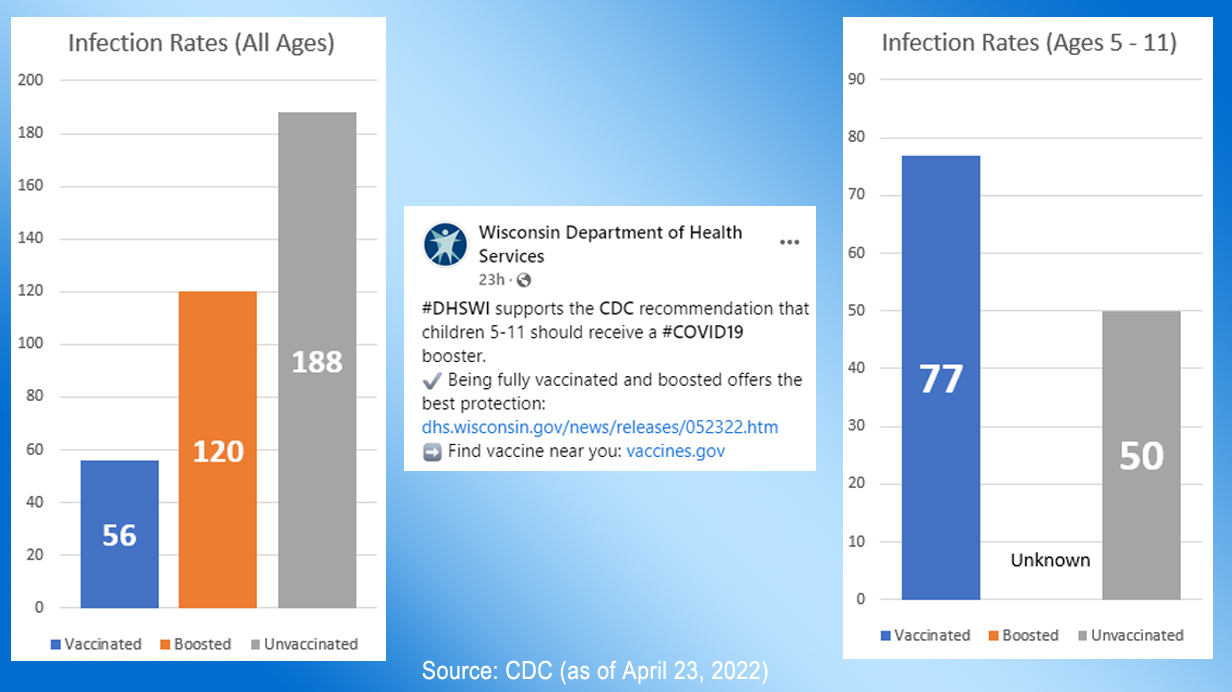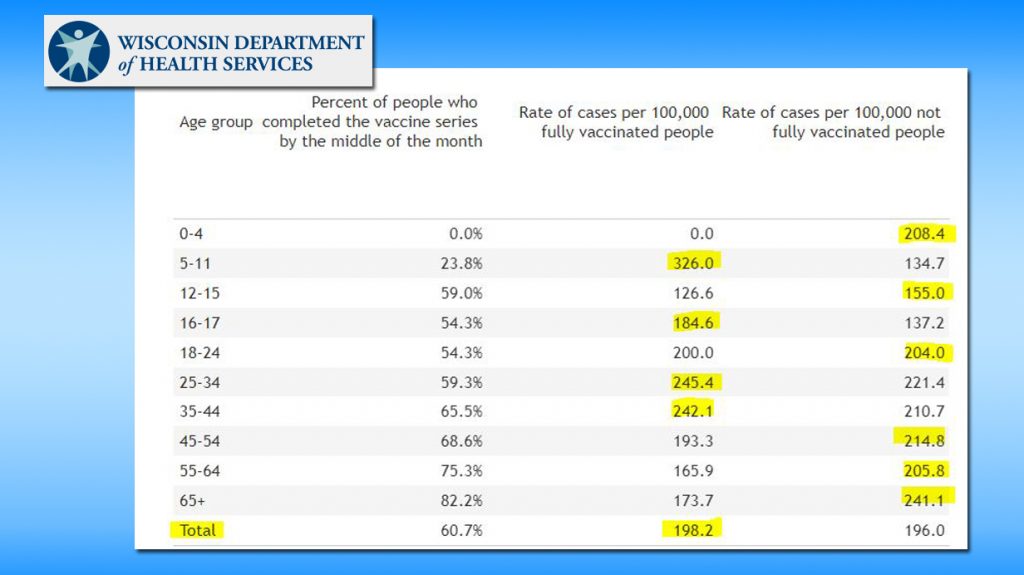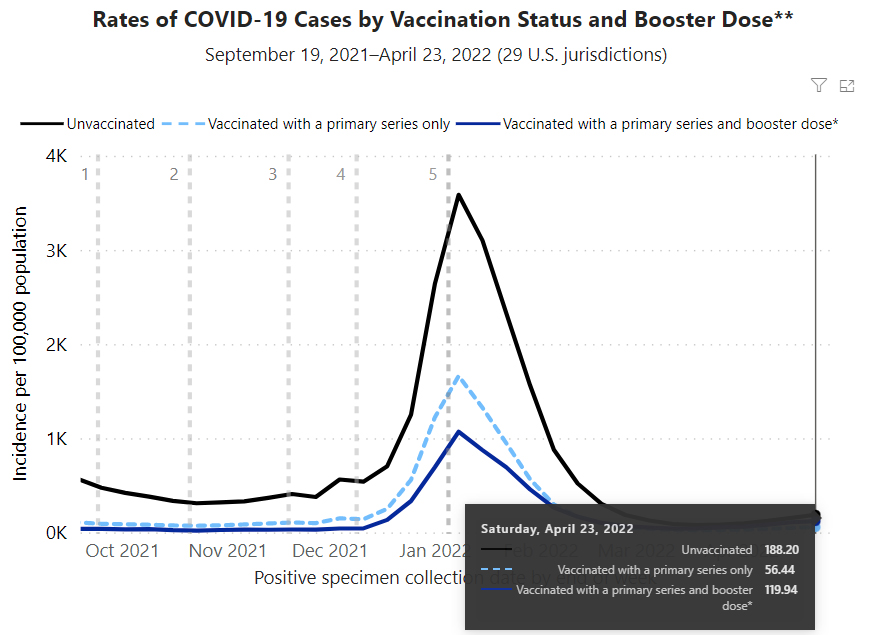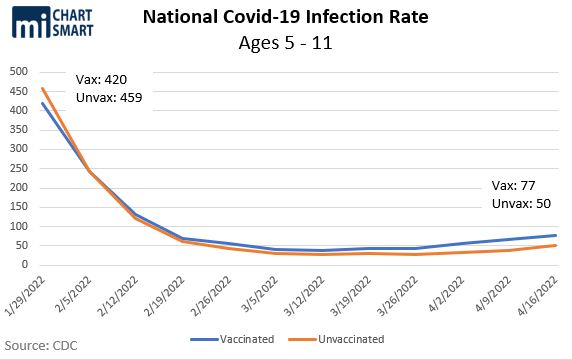
May 24, 2022 | MacIver News Service
By Bill Osmulski
Why do government officials want you to vaccinate your child when that will increase their chances of catching Covid (according to their own data)?
Why do they want you to get your child a booster shot when that increases their chances of catching Covid even higher than that (again, according to their own data)?
Why has DHS stopped reporting “illness after vaccination” data to the public right as these trends were starting to emerge?
These are obviously very important questions.
National Data
The Centers for Disease Control (CDC) tracks Covid-19 infection rates for various age groups according to vaccination status for a good portion of the country.
Its data shows that people in all age groups are far more likely to catch Covid-19 if they were boosted than if they only received the initial vaccine series. The infection rate is 120 per 100,000 for the boosted compared to 56 per 100,000 for the fully vaccinated.
The CDC also reports that vaccinated 5- to 11-year-olds are far more likely to catch Covid-19 than if they are not vaccinated at all. The infection rate is 77 per 100,000 for the fully vaccinated compared to 50 per 100,000 for the unvaccinated.
And yet, on Thursday, May 19th, the CDC’s Advisory Committee on Immunization Practices (ACIP) recommended that 5- to 11-year-olds get a booster shot. That flies in the face of the CDC’s own data.
Wisconsin Data
The state level data in Wisconsin should raise even more questions.
The Wisconsin Department of Health Services (DHS) reported in April that the infection rate among vaccinated children aged 5 to 11 was 2.4 times higher than their unvaccinated peers. The rate was 326 per 100,000 among the vaccinated and 134 per 100,000 for the unvaccinated.

And yet, on Monday, May 23rd, DHS recommended that everyone get their 5- to 11-year-olds boosted following the advice of the CDC.
“Clinical research demonstrated that a third dose of the Pfizer COVID-19 vaccine given after the second dose to children ages 5-11 helps give added protection against COVID-19, including infections from Omicron,” said Stephanie Schauer, Ph.D., Division of Public Health Immunization Program Manager.
Wisconsin DHS points to a study from the US Department of Health and Human Services (HHS) to justify its recommendation. The study examined health outcomes for children between the ages of 5 and 15 years from July 2021 to February 12, 2022, and concluded that two doses of the Pfizer vaccine reduced the risk of Omicron infection by 31%. It used those findings to recommend that children stay up to date on their Covid vaccinations.
Coincidently, right about the time that study ended, the vaccine outcome trends flipped. According to the CDC, right around Feb. 12th, the infection rate among vaccinated children (132 per 100,000) inched past the infection rate for unvaccinated children (121 per 100,000). That gap has steadily widened since then. The most current data shows it’s now 77 per 100,000 for vaccinated children and 50 per 100,000 for unvaccinated children. The CDC has not updated that dataset since the third week in April.
DHS is also dragging its feet. It was supposed to update its “illness after vaccination” dataset on May 20th, according to its website. That provides infection, hospitalization, and death rates by vaccination status in Wisconsin. It’s now May 24th, and it still has not been updated. The MacIver Institute asked DHS on May 17th if it planned to update the data this month, but has not yet received a response.
The last time DHS updated the data was on April 14th. That was a big deal, because it had not been updated in over two months. DHS told MacIver that it was upgrading its website. A lot happened during that interlude.
Previously, DHS’ data showed that unvaccinated individuals had higher rates of infection, hospitalization, and death. That’s no longer the case.
On April 14th, DHS’ data showed that among all age groups, the infection rates were higher among the vaccinated (198.2 per 100,000) than the unvaccinated (196 per 100,000). The breakdown showed individuals had a higher rate of infection if they were 5-11, 16-17, or 25-44 years old.
Officials might try to pivot and point towards hospitalization data. However, that’s not always helpful to their cause either. In Wisconsin, the hospitalization rate among vaccinated 12- to 15-year-olds (2.3 per 100,000) is significantly higher than the rate for their unvaccinated peers (1.6 per 100,000).
The age-breakdowns on DHS’ Illness After Vaccination webpage is obviously helpful in fact checking official policies. Unfortunately, DHS only posts that data for 30 days at a time. Each time the page is updated, the previous month’s data is replaced with the latest data. The old data is deleted. That means we don’t know how these trends developed between January and April while the website was being upgraded. If DHS does not update it again soon, we might never know what the age-breakdowns were for April. It is intriguing how DHS stopped updating the page as soon as the data no longer supported official policies such as vaccinating and now boosting children. It seems they can no longer point to the data to support their policies, and not surprisingly, their interest in the data is fading.

